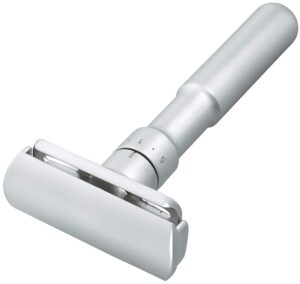The Real Cost of Disposable Razors
In the early ’90s, the U.S. Environmental Protection Agency reported that America produced 2 billion disposable razors and blades.
According to a more recent report by Statista, 163 million consumers in the U.S. used disposable razors in 2018.
Of the 260 million tons of plastic that the world produces each year, around 10 percent ends up in the ocean.
Over a million sea animals lose their lives each year due to the plastic content in the sea.
Disposable razors are not an unavoidable consequence of modern life. They are a choice imposed upon us through a throwaway culture that prizes repeat purchases of low quality over making a product to last.
The Financial Cost
That’s not the only cost involved with plastic razors. We all know how expensive razors can be. In 2009 the UK Government watchdog the Office of Fair Trading exposed the huge markups charged by razor companies like Gillette.
The products cost as little as 5p to make, industry insiders have revealed but consumers were charged up to £2.43 a piece – a mark-up of more than 4,750%.
A pack of four Fusion Power cartridges costs only 20p to manufacture, plus 8p for packaging. But they were sold for £9.72 – a mark-up of £9.44. Ten years later that price has not come down.
As for the environmental impact, we no frequently see brands attempt their own recycling schemes but these are often shortlived. No one wants to go out of their way to post their old razor heads.
And this tends to be the higher end brands and not cheap disposable razors. Every disposable razor is made of a complex mix of materials – the grip, the blades, any lubricating pieces – that makes them very difficult to recycle.
It wasn’t always the case that our morning routines had such a terrible impact on the world. It was just over a century ago that the safety razor became a widespread convenient upgrade on the straight razor.
It was a single double edge blade in a three-part steel mechanism and delivered a shave that a five-bladed cartridge today would struggle to compete with.

That double edge razor blade would last up to a week if you used both sides. Not only are these classic safety razors still available today, but we have the recycling facilities to take the blades.
What’s more is that with so much packaging disposable razors take a lot of space in transport – all for just a small cutting surface.

With double edge razor blades, ten thin blades can stack up into a little box that’s less than the size of a matchbox. One of these boxes of blades costs just a few dollars for several weeks’ worth of shaves.
It seems likely that this is the reason safety razors seem such a guarded secret. Razor companies are always trying to reinvent the wheel with new razors, blades and lubricants when truthfully all anyone needs is a safety razor that could last a lifetime. The only (very low cost) recurring purchase is the blades. It is the ultimate eco-friendly razor.
And while you’re fighting back against waste with safety razors, you can also disregard aerosol shaving foams and try a solid bowl of shaving soap that will also last much longer.
You don’t need to declare your masculinity or feminity with a brightly coloured plastic razor like you see in the adverts. The steel safety razor is simple, elegant and utilitarian and switching could make a big difference to your wallet and the planet.

